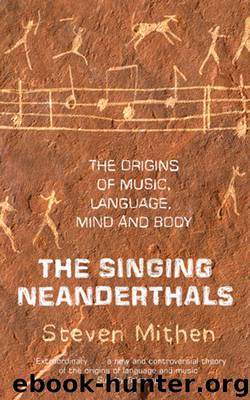The Singing Neanderthals by Steven Mithen

Author:Steven Mithen [MITHEN, STEVEN]
Language: eng
Format: epub
Publisher: Orion
Published: 2011-12-08T05:00:00+00:00
Imagine a group of hominids – members of the Homo heidelbergensis species – clustered around the carcass of a horse on the banks of a wet and muddy lagoon. Two of them are expertly cutting tendons with hand-axes; others watch them at work, and another is returning from a nearby cliff-face with a flint nodule from which he will make another hand-axe. As they work, the Early Humans communicate using ‘Hmmmmm’ – gestures, body language and mime combined with holistic utterances, many of which have a highly musical nature. The adult males are the loudest and have the most extrovert movements; in the background a gentler form of communication is under way, between mothers and their infants. That is the subject of this chapter: how the need for mother-infant communication was a further selective pressure for the evolution of ‘Hmmmmm’, and ultimately for the capacities for music and language in modern humans.
Boxgrove: discovery, excavation and interpretation
Boxgrove is a truly remarkable site because so many of the animal bones and stone artefacts remain exactly where they were discarded half a million years ago, having been rapidly but gently buried in the mud of the lagoon.1 This has allowed archaeologists to reconstruct Early Human activities in far more detail than they can elsewhere; the vast majority of sites of this period were long ago washed away by rivers, leaving the stone artefacts rolled and battered in gravel deposits just as if they were unworked pebbles. At Boxgrove, the scatters of flakes show precisely where the flint-knappers sat and shaped their tools; numerous flakes have been refitted to show exactly how they were removed from amorphous nodules to shape almost perfectly symmetrical ovate hand-axes.2
Boxgrove is one of the earliest archaeological sites in Britain – indeed in the whole of northern Europe. It was occupied during an interglacial period when the sea level was low and Britain was no more than a peninsular of the continent. With the retreat of the ice sheets, Homo heidelbergensis had spread northwards, living on animals acquired by either hunting or scavenging, and exploiting plant foods from the woodland that now flourished in the warmer and wetter climate. Indeed, much of Britain at 0.5 million years ago would have been thickly covered in trees, which were useful for collecting berries and nuts, and sleeping secure from carnivores, but not for hunting and scavenging. For those activities the coastal plain and marshes would have been preferred, as is apparent from the excavations at Boxgrove. The site provides not only an insight into the behaviour of Homo heidelbergensis but also a vivid glimpse of the interglacial environment, as a great many other animals lived and died in its vicinity. The bones of elephant, rhino, horse, deer, lion, wolf and hyena have been excavated, along with those of smaller animals such as beavers, hares, voles, and frogs. It had been a vibrant, heavily populated landscape, a northern-latitude Serengeti.
Many of the horse, deer, and rhino bones have cut-marks from stone tools. Some of
Download
This site does not store any files on its server. We only index and link to content provided by other sites. Please contact the content providers to delete copyright contents if any and email us, we'll remove relevant links or contents immediately.
Sapiens: A Brief History of Humankind by Yuval Noah Harari(14321)
Sapiens by Yuval Noah Harari(5325)
Pale Blue Dot by Carl Sagan(4957)
Homo Deus: A Brief History of Tomorrow by Yuval Noah Harari(4873)
Livewired by David Eagleman(3730)
Origin Story: A Big History of Everything by David Christian(3666)
Brief Answers to the Big Questions by Stephen Hawking(3393)
Inferior by Angela Saini(3294)
Origin Story by David Christian(3170)
Signature in the Cell: DNA and the Evidence for Intelligent Design by Stephen C. Meyer(3099)
The Gene: An Intimate History by Siddhartha Mukherjee(3075)
The Evolution of Beauty by Richard O. Prum(2965)
Aliens by Jim Al-Khalili(2803)
How The Mind Works by Steven Pinker(2778)
A Short History of Nearly Everything by Bryson Bill(2662)
Sex at Dawn: The Prehistoric Origins of Modern Sexuality by Ryan Christopher(2500)
From Bacteria to Bach and Back by Daniel C. Dennett(2462)
Endless Forms Most Beautiful by Sean B. Carroll(2444)
Who We Are and How We Got Here by David Reich(2418)
